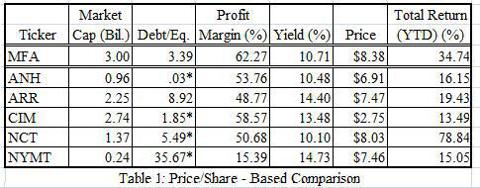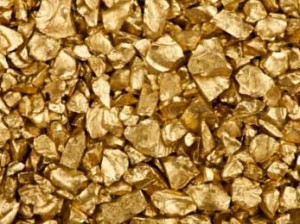Benefiting from a special tax structure, mREITs are able to avoid burdensome taxes by distributing 90% of corporate profits to shareholders in the form of dividends. These high dividend-yielding stocks, ranging from around 6% to 18% distribution rate have proven to be extremely attractive to investors. Many mREITs like MFA financial (MFA) and Invesco Mortage Capital Inc (IVR) have dividend rates of 10% and 13% as well as 1 year stock growths of 23% and 30% respectively. Stockholders’ compounding of dividends combined with generally speaking attractive yields may result in continuous stock growth despite moments of economic uncertainty.
Compound interest is the eighth wonder of the world. He who understands it, earns it … he who doesn’t … pays it. – Albert Einstein
So it does seem as though mREITs are high-yielding investments. But one must wonder what are the risks? mREITs are able to turn profits by borrowing money at a certain rate, say 1%, and then lending it out at a higher rate, say 1.3%. These loans (mortgages) are backed by real estate securities, which allows them to leverage the amount borrowed by more than 5 times the amount of cash they have on hand. This means that a 0.1% increase in interest rates in the economy would lead to shrinking profit margins of many percentage points for leveraged mREITs. mREITs are profitable while interest rates are stable but can be extremely affected  for the worst if interest rates rise or decline by too much. Profit losses for mREITs directly result in a cut in dividend yields, which is usually a SELL sign to investors.
for the worst if interest rates rise or decline by too much. Profit losses for mREITs directly result in a cut in dividend yields, which is usually a SELL sign to investors.
One must therefore be wary of mREITs and keep in mind economic factors that may directly affect interest rates and therefore company performance. The Treasury’s recent quantitative easing policy is one to keep in mind…!

 Microsoft executives say the recent release of tablet-friendly software Windows 8 is the beginning of a new generation of products. Since its release, new computers and computer designs have been becoming increasingly popular. For example, just last week Lenovo released its new laptop, the Ideapad Yoga 13, a 1.7Ghz ultrabook with an hd touch-capable screen that can be manipulated around 360 degrees. The idea behind these new laptop designs is that they are as portable as macbook airs, one of apple’s best-selling computers, while integrating user-adored tablet features. This chimera of a laptop, like a blend between a macbook air and an ipad, bridges many consumers’ need for a piece of technology that is portable, fun, and even more importantly useful. Windows 8 is the bridge between work and fun, between gadget and productive capital.
Microsoft executives say the recent release of tablet-friendly software Windows 8 is the beginning of a new generation of products. Since its release, new computers and computer designs have been becoming increasingly popular. For example, just last week Lenovo released its new laptop, the Ideapad Yoga 13, a 1.7Ghz ultrabook with an hd touch-capable screen that can be manipulated around 360 degrees. The idea behind these new laptop designs is that they are as portable as macbook airs, one of apple’s best-selling computers, while integrating user-adored tablet features. This chimera of a laptop, like a blend between a macbook air and an ipad, bridges many consumers’ need for a piece of technology that is portable, fun, and even more importantly useful. Windows 8 is the bridge between work and fun, between gadget and productive capital. Since the 2010 oil spill BP’s stock has been staggering around $37-$45 despite posting outstanding third quarter profits and raising dividend by 14% to 5% a year. Most recently after their ex-dividend date BP’s stock dropped from $43 to under $40, or by more than 2.3%. The last time BP’s stock dropped below $40 was in August 2012, and shortly after it bumped up to $42.5 a share as its ex-date was approaching. BP, like most oil companies, can count on revenue well over $300 billion per year with increasing demand for oil through-out the world.
Since the 2010 oil spill BP’s stock has been staggering around $37-$45 despite posting outstanding third quarter profits and raising dividend by 14% to 5% a year. Most recently after their ex-dividend date BP’s stock dropped from $43 to under $40, or by more than 2.3%. The last time BP’s stock dropped below $40 was in August 2012, and shortly after it bumped up to $42.5 a share as its ex-date was approaching. BP, like most oil companies, can count on revenue well over $300 billion per year with increasing demand for oil through-out the world.

